Geology explores the Earth’s history through rocks and minerals, revealing transformation processes. Rocks, composed of minerals, offer insights into the planet’s formation and evolution over millions of years.
What is Geology?
Geology is the scientific study of the Earth’s physical structure, composition, and processes. It explores the planet’s history, including the formation of rocks, minerals, and landforms. Geologists examine how the Earth has evolved over billions of years, uncovering clues about its past through fossils, rocks, and geological events. The field is interdisciplinary, drawing from biology, chemistry, physics, and other sciences to understand the Earth’s systems. Geology not only helps us understand the Earth’s history but also addresses practical challenges, such as finding natural resources, mitigating natural hazards, and addressing environmental issues. By studying the Earth’s dynamics, geology provides insights into how our planet works and how we can sustainably use its resources for future generations.
Importance of Studying Rocks and Minerals
Studying rocks and minerals is crucial for understanding Earth’s history and managing natural resources. Rocks provide insights into the planet’s formation and evolution, while minerals are essential for various industries, from construction to technology. Minerals like quartz and copper are vital for electronics, and understanding their properties ensures sustainable extraction. Rocks and minerals also play a role in environmental management, as they influence soil quality and water systems. Additionally, studying them helps mitigate natural hazards, such as earthquakes and volcanic eruptions, by understanding geological processes. The economic importance of mineral resources is significant, driving industries and economies worldwide. By exploring rocks and minerals, scientists can address global challenges, ensuring responsible use of Earth’s resources for future generations while preserving the environment.
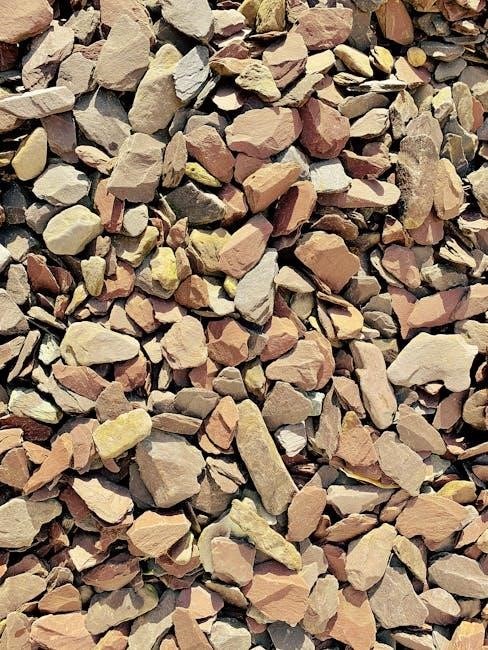
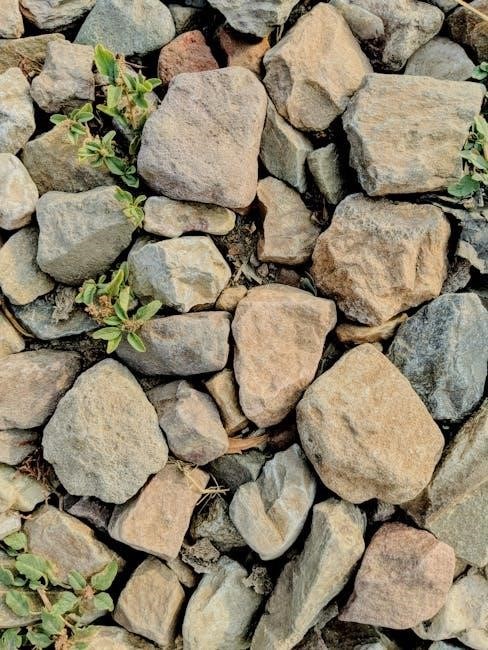
Key Concepts in Geology
Geology involves studying the Earth’s structure, composition, and processes. It examines minerals, rocks, and landforms, offering insights into the planet’s history, formation, and ongoing transformations.
What are Minerals?
Minerals are naturally occurring inorganic substances with a specific chemical composition and a crystalline structure. They form through geological processes, such as the cooling of magma or precipitation from mineral-rich waters. Each mineral has distinct physical properties, including color, hardness, and cleavage, which aid in identification. Minerals like quartz, feldspar, and mica are common in rocks, while others, such as gold and diamonds, are rare. Their formation often involves high temperatures and pressures, resulting in unique atomic arrangements. Minerals are the building blocks of rocks and play a crucial role in shaping the Earth’s crust. Understanding minerals provides insights into the Earth’s history and the processes that have shaped our planet over millions of years.
What are Rocks?
Rocks are solid, naturally occurring aggregates of one or more minerals. They form the foundation of the Earth’s crust and are classified into three main types: igneous, sedimentary, and metamorphic. Igneous rocks originate from cooled magma or lava, while sedimentary rocks are formed from compressed layers of mineral and organic particles. Metamorphic rocks result from the alteration of existing rocks under intense heat and pressure. Rocks vary widely in texture, composition, and color, reflecting their unique formation processes. For example, granite is a coarse-grained igneous rock, limestone is a sedimentary rock composed of calcite, and marble is a metamorphic rock formed from limestone. Rocks provide valuable information about the Earth’s history, including ancient environments, tectonic activity, and biological processes. Their study is essential for understanding the planet’s dynamic geological past and present.
Difference Between Rocks and Minerals
Rocks and minerals are distinct natural substances with specific characteristics. Minerals are pure, inorganic solids formed through geological processes, each with a unique chemical composition and crystalline structure. Rocks, on the other hand, are aggregates of one or more minerals, often combined with other organic or inorganic materials. Unlike minerals, rocks do not have a fixed chemical composition and can vary widely in their makeup. For example, granite is a rock composed of minerals like quartz, feldspar, and mica. Minerals are typically homogeneous, while rocks are heterogeneous, consisting of multiple mineral components. This fundamental difference highlights their unique roles in the Earth’s structure and formation processes.
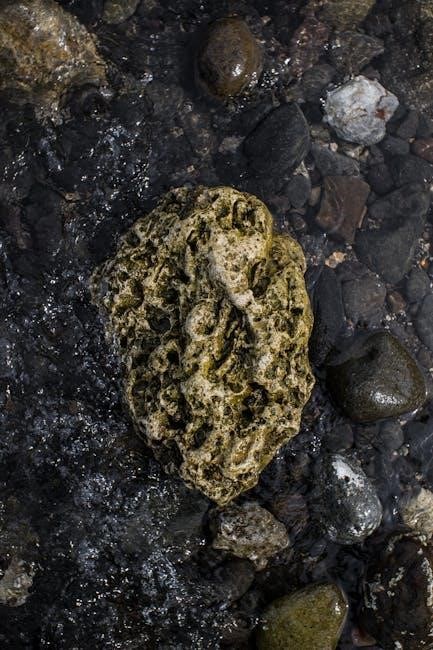
Formation Processes of Rocks and Minerals
Minerals form through cooling magma or geological processes, while rocks are composed of minerals created by weathering, sedimentation, or metamorphism, shaped by Earth’s dynamic conditions over time.
How Minerals Form
Minerals form through natural geological processes, primarily involving the cooling and solidification of magma or lava. This process allows atoms to arrange into crystalline structures, creating distinct mineral species. Additionally, minerals can form through metamorphism, where existing rocks are subjected to high temperatures and pressures, altering their composition. Weathering and erosion of rocks also contribute to mineral formation by exposing elements to environmental conditions that facilitate crystallization. Organic processes, such as those involving living organisms, can play a role in forming certain minerals, like calcite in shells. Each mineral’s unique properties are determined by the specific conditions under which it forms, making them invaluable for understanding Earth’s history.
How Rocks Form
Rocks form through three primary geological processes: igneous, sedimentary, and metamorphic. Igneous rocks develop from the cooling and solidification of magma or lava, resulting in crystalline structures. Sedimentary rocks are created through the accumulation and compression of mineral and organic particles, such as sand or plant material, over time. Metamorphic rocks form when existing rocks are transformed by high temperatures and pressures, altering their mineral composition without melting. Each process yields rocks with distinct textures and compositions, reflecting the conditions under which they formed. These processes are essential for understanding Earth’s dynamic history and the continuous cycle of rock formation and transformation.
The Role of Magma and Cooling Processes
Magma, molten rock beneath the Earth’s surface, plays a crucial role in the formation of igneous rocks. As magma cools, minerals crystallize and solidify, creating a rigid structure. The rate of cooling determines the texture of the resulting rock. Slow cooling deep within the Earth allows for the growth of large crystals, while rapid cooling at the surface produces finer textures. This process is fundamental to the formation of igneous rocks, which can be either intrusive (e.g., granite) or extrusive (e.g., basalt). Cooling processes also influence the distribution and concentration of minerals, shaping the Earth’s crust. Magma’s movement and solidification are key drivers of geological activity, including volcanic eruptions and the creation of mountain ranges.
Types of Rocks and Their Characteristics
Rocks are classified into igneous, sedimentary, and metamorphic types, each with distinct textures and compositions shaped by their unique formation processes and mineral content.
Igneous, Sedimentary, and Metamorphic Rocks
Rocks are broadly categorized into three types: igneous, sedimentary, and metamorphic, each formed through distinct geological processes. Igneous rocks originate from the cooling and solidification of magma or lava, resulting in textures that range from coarse-grained, like granite, to fine-grained, such as basalt. Sedimentary rocks are formed through the accumulation and compression of mineral and organic particles, often in layered structures, as seen in sandstone or limestone. Metamorphic rocks, such as marble or slate, develop when existing rocks are altered by heat and pressure, transforming their mineral composition and structure. Each type reflects unique conditions of formation, offering insights into Earth’s history and geological activity.
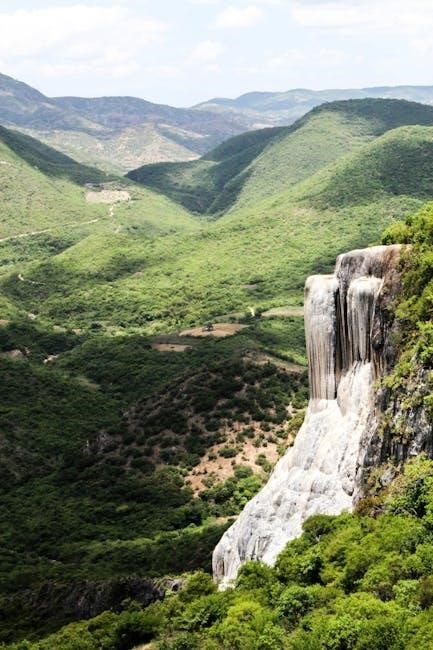
Common Minerals Found in Rocks

Minerals like quartz, feldspar, and mica are prevalent in igneous and metamorphic rocks, while calcite and gypsum are common in sedimentary formations. These minerals form through cooling magma, sedimentation, or metamorphic processes, each contributing to a rock’s unique composition and properties. Silicate minerals, such as olivine and pyroxene, are fundamental in igneous rocks, whereas carbonates like calcite dominate sedimentary rocks. Economic minerals, including iron oxides and copper sulfides, are often concentrated in specific rock types. Understanding these minerals is crucial for identifying rock classifications and their origins, providing insights into the Earth’s geological history and resource potential. Each mineral’s presence reveals distinct formation conditions, making them essential for geological studies and practical applications in various industries.
Silicate Minerals and Their Significance
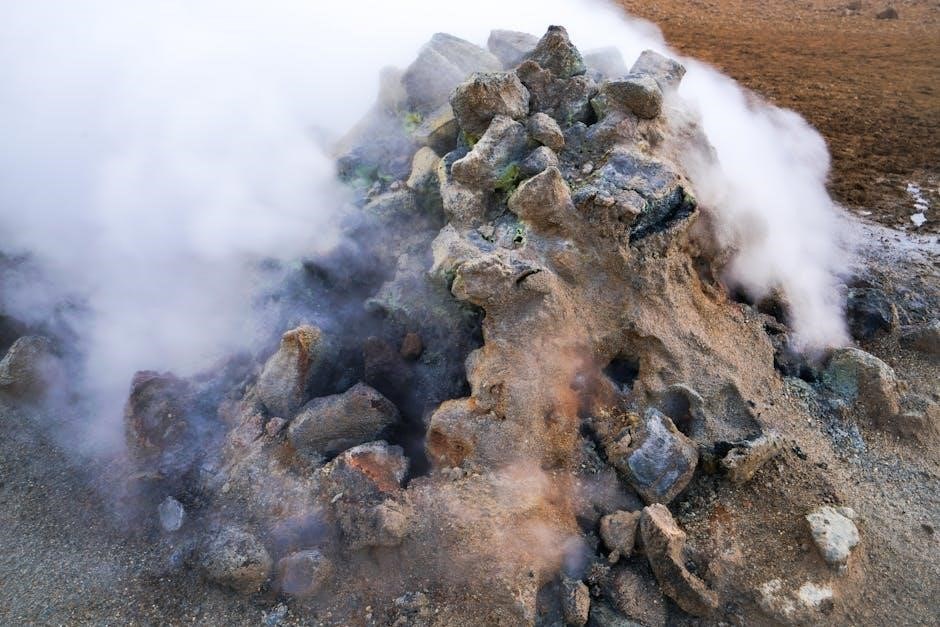
Silicate minerals are the most abundant group of minerals, forming the backbone of many rocks. They are characterized by their silicate anion structure, which consists of silicon and oxygen atoms bonded with other elements. Common silicate minerals include olivine, pyroxene, amphibole, and mica. These minerals are foundational in igneous, sedimentary, and metamorphic rocks, with quartz being one of the most prevalent. Silicates like zircon and titanite are valued for their durability and resistance to weathering. The study of silicate minerals provides insights into the Earth’s thermal and tectonic history, as their formation often reflects specific pressure and temperature conditions. Additionally, silicates play a critical role in soil formation and nutrient cycling, making them essential for ecosystems and agricultural productivity. Their diversity and ubiquity underscore their significance in geological and environmental studies.

Practical Applications and Economic Importance
Minerals are essential components in various industries, from construction to electronics. Their unique properties drive innovation and economic growth, making them vital for advancing technology and societal development.
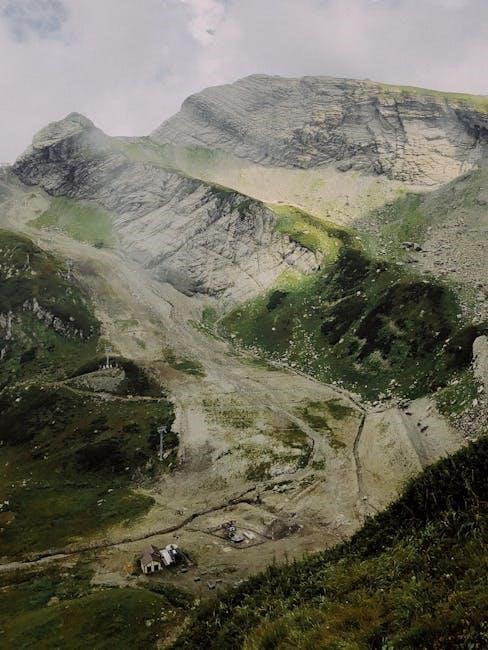
The Economic Importance of Mineral Resources
Mineral resources are a cornerstone of global economic development, driving industries such as agriculture, manufacturing, and technology. They are essential for producing metals, fuels, and raw materials used in construction and electronics. The extraction and trade of minerals contribute significantly to national economies, creating jobs and fostering innovation. For instance, rare earth minerals are critical for advanced technologies like smartphones and renewable energy systems. Additionally, mineral deposits, such as copper and iron, are vital for infrastructure development. The economic value of minerals lies in their unique properties, enabling industrial processes and technological advancements. Effective management of mineral resources ensures sustainable economic growth while addressing environmental concerns. Understanding their formation and distribution is key to maximizing their economic potential and meeting future demands.
